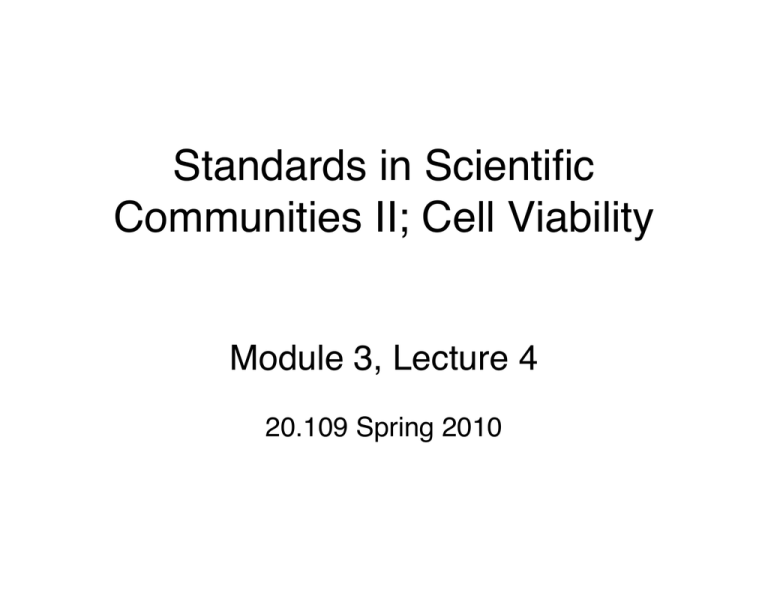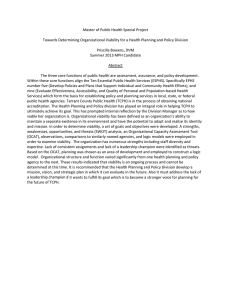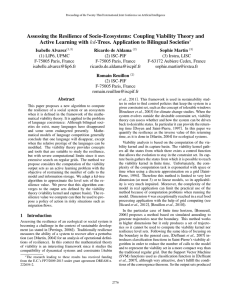Standards in Scientic Communities II; Cell Viability! Module 3, Lecture 4 !
advertisement

Standards in Scientic Communities II; Cell Viability! Module 3, Lecture 4! 20.109 Spring 2010! Lecture 3 review! Systems •! What can you learn from a condence interval? A t-test?" 'Can I have three inverters?' Devices •! What three general engineering principles might help make biology more “engineerable”?" 'I need a few DNA binding proteins.' Parts 'Get me this DNA.' DNA Image by MIT OpenCourseWare. See D. Endy, Nature 438:449! 2! Topics for Lecture 4! •! Standards in tissue engineering" –! introduction" –! writing exercise" –! discussion" •! Cell viability" –! your data" –! relation to diffusion" 3! How valued are TE standards?! •! 2007 strategic plan for TE clinical success by 2021# !! 24 int"l leaders in TE listed high-priority areas# !! 1/3 named standards# •! Analysis# !! concept dominance# !! progress so far# !! standards 7th of 14# 4. Cell sourcing/characterization.# 7 (tie). Standardized models.# P.C. Johnson et al., Tissue Eng 13:2827 (2007)# •! 2007 US govt. strategic plan# Courtesy of Mary Ann Liebert, Inc. Used with permission. Source: Johnson, P. C., et al. "Strategic Directions in Tissue Engineering." Tissue Eng 13, no. 12 (2007): 2827-2837. doi:10.1089/ten.2007.0335. –! standards listed as part of “implementation strategy”# 4! How useful are TE standards?! •! See 2005 editorial by A. Russell " –! proposes need for standards " –! in data collection and sharing" •! Choose and respond to a student excerpt (~10#)" •! Pros/cons/etc… ? " Can we standardize this TE construct?! 5! Module progress: week 2! •! Day 3: viability/cytotoxicity testing" •! Groups generally found " –! mostly live" –! mostly round" –! some clustering" •! How do we explain the results?" •! How can we improve the assay?" •! What conditions killed cells?" Image from W/F Yellow Group" 6! Factors affecting cell viability! •! Cell-related" –! density" –! interactions" •! Cytokine-related" –! proliferative" –! apoptotic" •! Materials-related" –! bulk permeability" –! macro-porosity" –! toxicity" 7! Diffusion in 3D constructs! •! Nutrients, O2" •! Affected by" Dalginate! R! •! Concentration prole" –! can be solved (DE)" –! [O2] toward center" –! steepness = f(D, !, ...)" !! [O2]bulk! [O2] ! –! construct size R" –! cell density !" –! diffusivity D" –! conc. in medium [O2]bulk " Dliq! center! position (r)! edge! 8! Signicance of diffusion in TE! •! Characteristic limit ~100 µm" •! Diffusion and viability proles correlated" •! How can we make thick tissues?" !! in vitro: dynamic/perfusion culture" !! in vivo: promote rapid angiogenesis! Photo removed due to copyright restrictions. perfusion system" zeiss.com.sg! 9! Modeling cell viability in TE constructs! •! •! •! •! Porous PLGA scaffolds" Seeded cells as in (A) or (B)" Observed after 10 days" Model includes" –! Diffusion" –! O2 use" –! Cell growth" A! Cells in odd layers! B! Cells in all layers! •! Model assumes" –! [O2]bulk is constant" –! Quasi-steady state " Dunn, et al. Tissue Eng 12:705 (2006)" Courtesy of Mary Ann Liebert, Inc. Used with permission. Source: Dunn, J. C. Y., et al. "Analysis of Cell Growth in Three-Dimensional Scaffolds." Tissue Eng 12, no. 4 (2006): 705-716. 10! Dunn et al. results for cell viability! center! Cell density! •! A more uniform than B" •! Cell growth matches O2 tension" •! Claim of predictive capability" < 1M cells/cm3! < 1M cells/cm3! Distance from edge! 11! Courtesy of Mary Ann Liebert, Inc. Used with permission. Source: Dunn, J. C. Y., et al. "Analysis of Cell Growth in Three-Dimensional Scaffolds." Tissue Eng 12, no. 4 (2006): 705-716. Lecture 4: conclusions! •! Strategies besides standardization may take precedence in some BE elds." •! Cell viability in TE constructs is affected by cell, material, and soluble factors." •! Modeling can elucidate nutrient diffusion and cell viability proles." Next time: transcript and protein assays; advice for module 2 report revision." 12! MIT OpenCourseWare http://ocw.mit.edu 20.109 Laboratory Fundamentals in Biological Engineering Spring 2010 For information about citing these materials or our Terms of Use, visit: http://ocw.mit.edu/terms.


